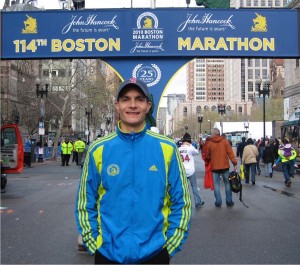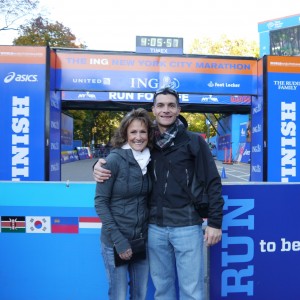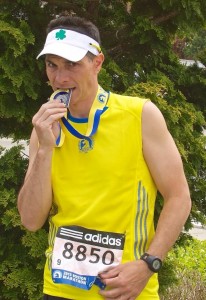
Dr. Tony Agtarap ran the Boston Marathon. Three times. He completed the New York Marathon twice. And he finished the Chicago Marathon once. So, it’s safe to say, he knows how to run. And more than that, he knows how to train properly, and successfully, for a long distance race. However, Dr. Agtarap, an orthopaedic surgeon and knee specialist at Olympia Orthopaedic Associates, wasn’t a competitive runner until the age of 40.
Dr. Agtarap has been treating patients in Olympia for over 20 years and as an orthopaedist with a focus on the knee, he naturally saw patients who were active, particularly runners. “Early in my career I spent a few years volunteering in the medical tent at the Capital City Marathon. I thought, ‘Eventually I’ll get back to running and I’d love to run this race,’” he explains. He started, as many runners, with a 5K then a 10K and eventually ran his first half-marathon and marathon. He’s logged at least 20 half-marathons and over 10 full marathons to date.
“I ran cross-country in high school and had some interest in running. After a 20 year hiatus I re-engaged with the sport,” says Dr. Agtarap.
After his third marathon, increasing time with each race, Dr. Agtarap qualified for the elite Boston Marathon. “Running is interesting in that it’s one of the few things where in your 30s and 40s you can continue to excel and actually be pretty competitive whereas a lot of athletic endeavors stop at age 25 or so,” he says.

The Boston Marathon is considered by most distance runners as the pinnacle of racing. “It’s a race that’s been around for nearly 115 years,” Dr. Agtarap explains. “It’s considered the grandfather of all races and all the best runners are there. You earn the right to be there and you’re running with the best athletes in the world.”
With three of the “World Marathons” (Berlin and London are the other two) under his belt, Dr. Agtarap has begun having more fun with his running and not just competing. “I’ve had the chance to be a pacer in a few marathons. I’ll carry a sign with a specific race time and other runners stay with me, trying to hit that time,” he explains. “That’s kind of fun because you’re a coach on the course, helping runners hit their goals.”
He’s known off the course, too, for his knowledge of the sport. “I’m getting to be known as a runner and I get the pleasure of caring for a lot of athletes who come in and want help to keep running,” says Dr. Agtarap. “Trying to help them, as their doctor, but also a bit as a coach, shedding some light on knee related injuries, is a lot of fun.”
With all his experience, we asked Dr. Agtarap to share some advice for local runners training for distance races, whether their first half-marathon or their tenth full.
- Sign up – Plan ahead and sign up for your race early. Once you’ve made that commitment you are much more likely to follow through.
- Set your goal – Do you just want to finish or do you want to race for time? Those are two very different things, according to Dr. Agtarap, and your training will be different for each one.
- Establish comfortable, base-level running – Before attempting longer distances, make sure you are running comfortable at your everyday distances and you can complete a 5K or a 10K without physical issues. Feeling good with your daily runs, establishing routines and patterns, will enable you to handle the training for longer distances.
- Create a realistic training schedule – Dr. Agtarap recommends a minimum of 12 weeks to train for a distance event with novice runners extending to a minimum of 16 weeks. Don’t sell yourself short. Allowing enough training time ensures better results come race day.
- Build a training program – Whether you use online resources, join a running group, use a training specific book or hire a coach, build your training program purposefully. “There are many philosophies about training,” shares Dr. Agtarap. “I think the simplest way is to build volume of running, either minutes or miles, over three consecutive weeks. The fourth week should be a recovery week.” This strategy prevents injury, overuse problems and burnout. Repeat this rhythm throughout your training weeks.
-

Dr. Agtarap’s experience running helps him understand the unique needs of his patients at Olympia Orthopaedic Associates where he specializes in knees. Mix up your training – “Pounding the pavement every day will result in what we call, ‘tissue issues,’” says Dr. Agtarap. Keep running your main focus but cross train with flexibility, strength training, cycling and swimming.
- Address obstacles quickly – Whether physical or mental, there will be bumps in the road. Don’t wait until they get serious. See your primary care physician, an orthopaedist or trainers and coaches within your running group as there are many things you can do to modify training, allowing you to still compete.
- Re-evaluate – Check in with yourself as your event nears. Are you healthy? Is your goal the same? Is your training on point?
- Finish strong – Stay healthy, rest, eat right, hydrate well. Take care of yourself in the week preceding your event. You don’t want your efforts to be wasted if you aren’t healthy on race day.
- Plan your race – Show up on race day with a plan. Set small milestones for sections of the course and track your progress. Hold back in the first half, saving yourself to finish strong on the second half. Don’t wear or use any new gear. Stick with what you know works for you including your nutrition. A new protein bar or gel on course may spell disaster for your GI tract.
- Enjoy the results – When all is said and done, don’t forget to take it all in after your race. Enjoy the rush of reaching your goal, accomplishing something big. Then, stretch, get some food and water, take a short jog or walk to loosen up and celebrate.
You can visit Dr. Agtarap at the Olympia Orthopeadics Associates Eastside Clinic where he sees patients, runners or not, for knee related issues. Make an appointment by calling 360-709-6230.

















































